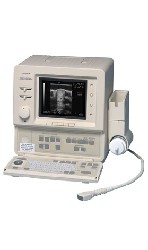Medical Ultrasound Imaging
Wednesday, 8 May 2024
'Linear Array Transducer' Searchterm 'Linear Array Transducer' found in 22 articles 1 term [ • ] - 12 definitions [• ] - 9 booleans [• ]Result Pages : • Linear Array Transducer
Linear array transducer elements are rectangular and arranged in a line. Linear array probes are described by the radius of width in mm. A linear array transducer can have up to 512 elements spaced over 75-120 mm. The beam produced by such a narrow element will diverge rapidly after the wave travels only a few millimeters. The smaller the face of the transducer, the more divergent is the beam. This would result in poor lateral resolution due to beam divergence and low sensitivity due to the small element size. In order to overcome this, adjacent elements are pulsed simultaneously (typically 8 to 16; or more in wide-aperture designs). In a subgroup of x elements, the inner elements pulse delayed with respect to the outer elements. The interference of the x small divergent wavelets produces a focused beam. The delay time determines the depth of focus for the transmitted beam and can be changed during scanning. Linear arrays are usually cheaper than sector scanners but have greater skin contact and therefore make it difficult to reach organs between ribs such as the heart. One-dimensional linear array transducers may have dynamic, electronic focusing providing a narrow ultrasound beam in the image plane. In the z-plane (elevation plane - perpendicular to the image plane) focusing may be provided by an acoustic lens with a fixed focal zone. Rectangular or matrix transducers with unequal rows of transducer elements are two-dimensional (2D), but they are termed 1.5D, because the number of rows is much less than the number of columns. These transducers provide dynamic, electronic focusing even in the z-plane. See also Rectangular Array Transducer. •  From ALOKA Co., Ltd.;
From ALOKA Co., Ltd.;'A High-Quality, Portable Veterinary Ultrasound System. The SSD-500V is a rugged, portable convex sector/linear scanner that offers versatility, superb image quality and reliable performance in a compact design. This 22 lb system has Electronic dynamic focus and 256 shades of gray that produces high-quality images. The SSD-500V includes comprehensive measurement and analysis packages. Measurements include distance/depth, area, circumference, velocity, heart rate, ratio and angle. The system also included obstetrical analysis functions that can calculate estimated gestational age and expected date of confinement. In addition, customized obstetrical tables can be easily created. The SSD-500V software package also includes left ventricular function software for M-mode Cardiac evaluation. The 500V provides excellent clinical versatility − for use in both small and large animal applications − using a wide range of optional convex and linear array transducers.' •
An array transducer is composed of multiple piezoelectric crystal elements arranged in an array. Arrays are transducer assemblies with a row of elements, used to focus the beam. Types of array transducers:
•
Linear array transducer = the arrays are arranged along a line.
•
Curvilinear or curved transducer = the arrays are arranged along a convex curve. A curved array is similar to a linear array except that the image created is a sector-type.
•
Annular array transducer = the arrays are arranged in concentric circles.
•
Rectangular array transducer = the arrays are arranged in a rectangular pattern.
See also Amplitude Shading, Transducer Types, and Transducer Assembly. Further Reading: Basics:
•
Convex transducers are today standard on every new scanner. A convex surface allows the scanning of a larger area with a smaller array. The method of focusing and beam sweeping of a convex or curvilinear / curved array is similar to a linear array transducer, except of the shape of the probe and the sector format of the created image. The better fit to the body, caused by the curved shape with smaller convex contact surface, and the wider field of view further from the transducer face are advantages in abdominal ultrasound. However, also a convex array is often too large to image the heart when probing between the ribs. Caused by combining a large field of view with smallest array size, phased array transducers are the best choice in cardiac ultrasound. See also Curved Transducer. •
A curved or curvilinear array transducer is similar to a linear array except that the image created has a sector-type format. A curvilinear array gives a large footprint and near field with a wide sector. Usually, curved transducers are described by the radius of curvature in mm. The transducer elements control the characteristics and direction of the sound beam. Curvilinear transducers have a wider field of view from the transducer face. Sector scanners are most useful for cardiac ultrasound examinations where the beam is directed between the ribs to image the heart. Also called convex transducer. Result Pages : |
Medical-Ultrasound-Imaging.com
former US-TIP.com
Member of SoftWays' Medical Imaging Group - MR-TIP • Radiology TIP • Medical-Ultrasound-Imaging
Copyright © 2008 - 2024 SoftWays. All rights reserved.
Terms of Use | Privacy Policy | Advertise With Us
former US-TIP.com
Member of SoftWays' Medical Imaging Group - MR-TIP • Radiology TIP • Medical-Ultrasound-Imaging
Copyright © 2008 - 2024 SoftWays. All rights reserved.
Terms of Use | Privacy Policy | Advertise With Us
[last update: 2023-11-06 01:42:00]




